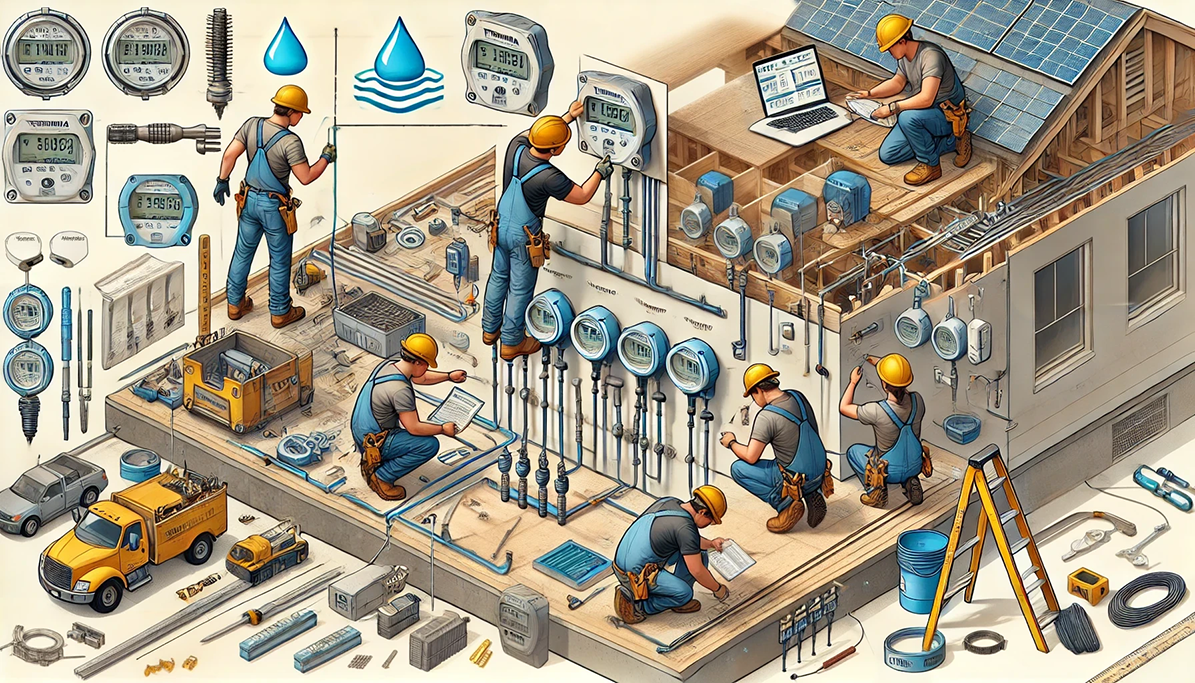Let’s Talk
Easy-to-Use Installation Guide for Tehama Wireless Submetering Solutions

Introduction
Welcome to Tehama Wireless! Our advanced submetering solutions, including both solar and non-solar products, are designed to be user-friendly and efficient. This guide will walk you through the installation process step-by-step, ensuring a smooth and hassle-free setup. If you need any further assistance, please feel free to contact our support team.
Watch our installation video for an overview of the Tehama Wireless system, including tips on setting up MDTs, repeaters, and the DCAP efficiently.
Pre-Installation Checklist
1. Verify Submetering Equipment: Ensure you have received all necessary components:- Transmitters (MDTs)
View Pulse MDT Data Sheet
View Submersible MDT Data Sheet
View Pulse Leak Sensor MDT Data Sheet
- Data Concentrating Access Point (DCAP) (available in both standard and solar models)
View DCAP Data Sheet
View DCAP-TFA Data Sheet
- Repeaters (available in both standard and solar models)
View Solar DCAP Repeater Data Sheet
View DCAP-MDT Repeater Data Sheet
- Connectors and cables
- Datasheets, app notes, and installation guides
2. Site Survey: Conduct a preliminary survey of the installation site to plan the placement of submeters and transmitters. Ensure there is adequate space and accessibility.
3. Tools Needed: Gather the required tools:
- Screwdrivers (Phillips and flathead)
- Drill and drill bits
- Measuring tape
- Cable ties
- Level
- Personal Protective Equipment (PPE)
4. Review Installation Plan: Have a copy of the installation plan provided by Tehama Wireless. Make sure all team members are familiar with the layout and steps.
Step-by-Step Installation
Step 1: Installing the Data Concentrating Access Point (DCAP)
1. DCAP Placement: Choose a central location within range of all transmitters.2. Mount the DCAP:
- Secure the DCAP to the wall or a stable surface using the provided brackets.
- Connect the power supply and turn on the DCAP.
- Ensure it is connected to the internet via Ethernet, Wi-Fi, or cellular for data transmission.
- For solar DCAPs, ensure the solar panel is positioned to receive optimal sunlight and connect the panel as specified in the guide.
Step 2: Setting Up the Submeters
1. Locate the Utility Lines: Identify the main utility lines where the submeters will be installed. Ensure the area is safe and follow proper safety protocols.
2. Install the Submeters:
- Turn off the utility supply before working on the lines.
- Carefully install the submeter on the designated utility line (water, gas, electric).
- Secure the submeter using the appropriate connectors and fittings.
- Turn the utility supply back on and check for leaks or any other issues.
Step 3: Mounting the Transmitters
1. Choose the Right Location: Select a suitable location near the submeter for the transmitter (MDT). Ensure it is within range of the DCAP and has minimal obstructions.
2. Mount the Transmitter:
- Use the transmitter’s mounting bracket to mark the mounting holes.
- Drill the holes and secure the bracket with screws.
- Attach the transmitter to the bracket and ensure it is level.
- Alternatively, you can use double sided tape/stickies
Step 4: Connecting the Submeters to the Transmitters
1. Run the Cables: Connect the signal cable from the submeter to the transmitter. Ensure the cable is properly secured and not exposed to potential damage.
2. Power the Transmitter:
- For battery-powered transmitters: Ensure the battery is properly installed and check that the transmitter is functioning correctly.
- For non-battery-powered transmitters: Connect the transmitter to the power supply and ensure it is functioning properly.
3. Syncing Devices:
- Follow the installation guide to sync the transmitters with the DCAP (ones that are within range)
- Ensure all devices are communicating correctly.
Step 5: Repeater Installation and Activation
1. Repeater Placement:
- Place repeaters in locations where they can effectively extend the network coverage. Avoid metal walls and electrical panels.
- Install repeaters in weather-sealed plastic boxes for outdoor setups, ensuring they are at least six feet off the ground to minimize tampering and optimize signal propagation.
2. Power-Up Sequence:
- Connect repeaters to the power supply.
- For solar repeaters, ensure the solar panel is positioned to receive optimal sunlight and connect the panel as specified in the guide.
- Power up the DCAP first to establish the network backbone.
- Next, power up the repeaters starting from the closest to the DCAP and moving outward. This sequence ensures proper network formation and communication checks during power-up.
3. MDT Activation:
- For MDTs, activate them by pressing the power button until the LED flashes. Verify communication by checking the LED status.
Step 6: Configuration and Testing
1. System Configuration:
- Access the DCAP’s interface via your computer or mobile device.
- Configure the system settings according to the guide provided.
2. Test the Setup:
- Run tests to ensure data is being accurately collected and transmitted.
- Verify that the data can be accessed and viewed via the Tehama Wireless platform.
- After repeater install and testing, check the MDTs furthest from a repeater/DCAP to ensure no signal loss.
Post-Installation
1. Secure All Cables: Use cable ties to organize and secure all cables, preventing any tripping hazards or damage.
2. Installation Review: Conduct a final review to ensure all components are properly installed and functioning.
3. Training: Provide a brief training session to relevant personnel on how to use and maintain the Tehama Wireless system.
Troubleshooting
If you encounter any issues during installation:
- Check Connections: Ensure all connections are secure and correctly configured.
- Review the Installation Guide: Refer to the specific guide for troubleshooting steps.
- Contact Support: Reach out to Tehama Wireless for assistance or call us at 1-415-495-7344.